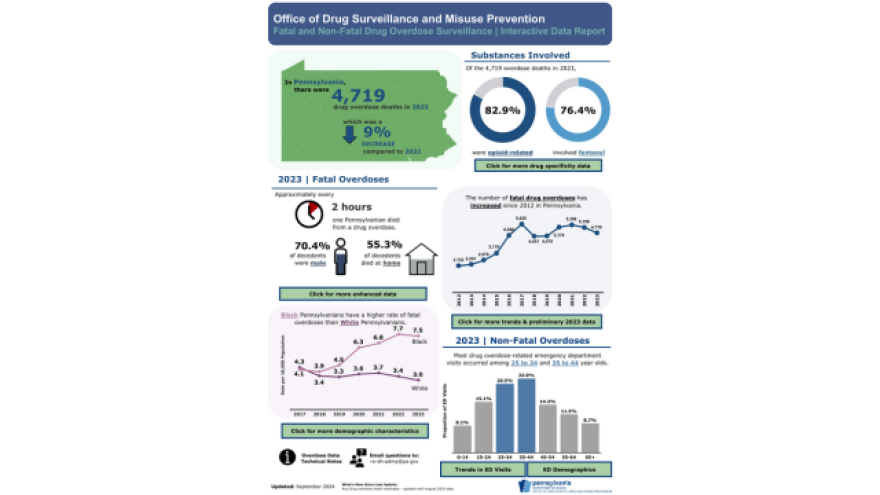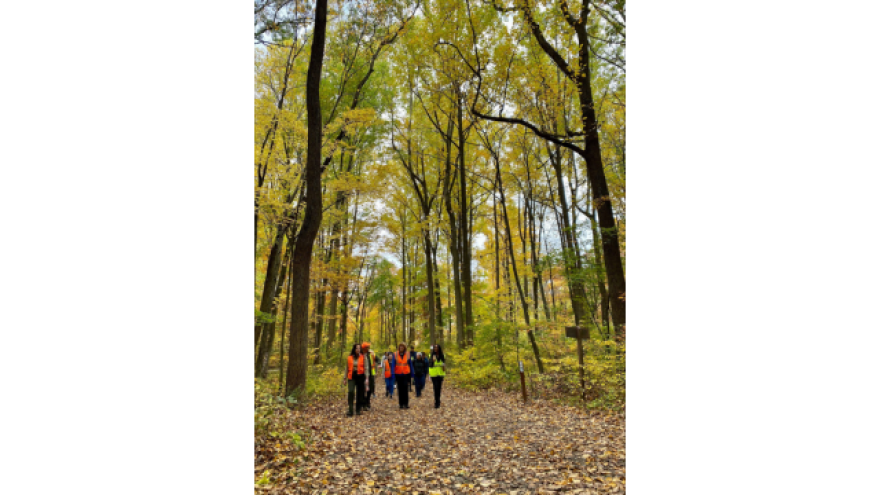BETHLEHEM, Pa. — When Joe Mattioli feels idle or disconnected, there's a noise in his head that he doesn’t quiet.
“That is my illness in the world — that is the addiction illness; that is the alcoholism illness,” said Mattioli, community support advisor for NorthBound & Co., a substance use recovery center based in Stroudsburg, Monroe County.
“So long-term recovery gets treated by me continuing to talk about that stuff in my head, but also being connected to other people, connected to meaningful things in the world, and having purpose, having joy in my life and sharing it with other people.”
Those feelings of community, purposefulness and joy are the focus of a statewide initiative launched this month, connecting two September observances — National Recovery Month and Pennsylvania’s Trails Month.
“We know that for those in recovery from a substance use disorder, spending time in nature can be a powerful tool in their journey and provide a boost in both mental and physical health."Dr. Latika Davis-Jones, secretary of the state Department of Drug and Alcohol Programs
Called the Recovery in Nature initiative, it joins the state departments of Drug and Alcohol Programs and Conservation and Natural Resources to create regional-specific partnerships, called hubs, to bolster substance use recovery efforts while strengthening all residents’ connection to nature.
The Lehigh Valley is in Region 9, which covers Lehigh, Northampton, Susquehanna, Wayne, Wyoming, Lackawanna, Luzerne, Carbon, Monroe and Pike counties.
NorthBound & Co. leads the regional recovery hub.
“We know that for those in recovery from a substance use disorder, spending time in nature can be a powerful tool in their journey and provide a boost in both mental and physical health," Dr. Latika Davis-Jones, secretary of the state Department of Drug and Alcohol Programs, said in a news release.
“The department is proud to partner with the Department of Conservation and Natural Resources to spotlight the natural beauty and opportunities Pennsylvania has to offer.
"Especially within our regional recovery hubs during such a meaningful time of year."
‘What happens after treatment’
Acknowledged each year for more than three decades across the United States, National Recovery Month is used by advocates as a time to shine an extra spotlight on the community, promote best treatment practices and thank service providers.
It can be a time of hope during a situation that can oftentimes feel incredibly dire.

There were 4,719 overdose deaths across the commonwealth last year, according to data from the state DAP. Even though it was a 9% decrease from the year prior, it was still one death approximately every two hours.
“Recovery needs may not be [the] same in Altoona as they are in Allentown,” Davis-Jones said during an announcement about the initiative.
“This will allow for each region to tailor their recovery supports by conducting ongoing needs assessments based on their area’s priorities.
“We must empower sustained recovery across the board.”
Getting appropriate treatment is a big part of that, advocates and health officials argue.
The Recovery in Nature initiative works by tailoring programs to specific regions through the hubs, which are “designed to embed, expand and promote a Recovery-Oriented System of Care, which is a coordinated network of community-based services and supports that is person-centered, with the ultimate goal of improving the health, wellness and quality of life for individuals in recovery from substance use disorder.”
‘Quiets that noise in the brain'
Northbound & Co. works to bridge the gap after treatment, Mattioli said.
“We believe that the state, the counties, the municipalities, they all do a great job of doing that emergency treatment — great funding and access to care is provided,” he said.
“And I'm so very proud to be a part of this organization, so proud of the state for this hub initiative, because it's one of the first times we've seen such a really broad look at supporting the back end of the recovery part, like what happens after treatment.”Joe Mattioli, community support advisor for NorthBound & Co.
“But what happens after that is often what we talk about.
“And I'm so very proud to be a part of this organization, so proud of the state for this hub initiative, because it's one of the first times we've seen such a really broad look at supporting the back end of the recovery part, like what happens after treatment.”
The initiative is all about making sure folks in recovery are connected to what they need to maintain it, from support services to medical resources, but also community.
While the recovery community has grown in recent years, there still can be stigmas attached — something advocates continuously work to reduce.
“And that's not always something I think people necessarily understand about substance use disorder,” Mattioli said. “It is truly an illness, one that exists in the brain, and alcohol and drugs are what people use that is the temporary solution.
“It quiets that noise in the brain. It temporarily solves that problem, but when you take that away, maybe the outside stuff looks better for a little bit, but the inside stuff doesn't get better unless people are treating it appropriately.”

‘More than just burning calories’
The effort gets its “in nature” distinction through a connection with Pennsylvania's Trails Month, created to acknowledge the state’s more than 12,000 miles of trails.
Each hub has then been paired with a corresponding trail or waterway within a state park or trail system. For the Lehigh Valley, it’s the D&L Trail from Lehigh Gorge State Park to Jim Thorpe, Carbon County.
Northbound officials have scheduled a Sept. 29 hike of the trail, just over two miles one way. Registration is strongly encouraged.
Walking is an accessible, low-risk and inexpensive form of physical exercise that's been shown to improve mental and physical health, Brit Kondravy said.
Kondravy is the conservation coordinator for the Delaware & Lehigh National Heritage Corridor, which manages the D&L Trail, as well as external lead for the Lehigh Valley Greenways Conservation Landscape.
It can be higher-quality movement than walking indoors or on a treadmill, she said.
“Walking outdoors is about so much more than just burning calories,” Kondravy said.
“I find that when you're walking outdoors, you're watching where you place your feet and you can feel the sun on your skin and you can feel the wind and you're maybe not listening to music or having TVs on.
"So you're just more in tune with your breath, and you're more in tune with what's moving around you, and maybe more inquisitive about what you're going to see around, like the next turn in the trail.
“When you're outside, it's really this invitation to be super mindful about your internal and external surroundings — and that's something that the treadmill for the gym just can't emulate.”Brit Kondravy, conservation coordinator for the Delaware & Lehigh National Heritage Corridor
“And from what I've seen, that awareness and that mind-body awareness, is so critical to recovery, because one of the biggest steps that you'll learn in recovery is that you just need to be focused on the present and try to stay as grounded as you can.
"When you're outside, it's really this invitation to be super mindful about your internal and external surroundings — and that's something that the treadmill for the gym just can't emulate.”
‘Journeys of remarkable wellness'
During the month, there are many activities in which residents can participate to get more outdoors time, including the D&L and St. Luke’s Get Your Tail on the Trail, the biking events through the Coalition for Appropriate Transportation and Community Bike Works.
Hopefully, the Recovery in Nature initiative works as a spark, advocates said, to create connections between residents and outdoor spaces that last past the end of the month.
“Those are the things that allow people not to have five days, but five years of long-term recovery, 10 years of long-term recovery."Joe Mattioli, community support advisor for NorthBound & Co.
“There's science behind why walking outdoors works, and then there’s that emotional piece on top of it,” Kondravy said.
“It's important for people to know that that's a resource, and it can be a tool in their toolkit, for their health whether they're in recovery or not having that struggle, but a tool for everybody.”
For Mattioli, events such as the upcoming hike help to bolster his long-term recovery and wellness. He said he sees the positive impact in others, too.
“Those are the things that allow people not to have five days, but five years of long-term recovery, 10 years of long-term recovery,” he said.
“That's where you get to see, I believe, people have lifelong journeys of remarkable wellness.
“And as a society, as a community, we get to have a whole bunch of us being able to not just get well and stay well, but be able to contribute and give back and be meaningful members of the community together.”


